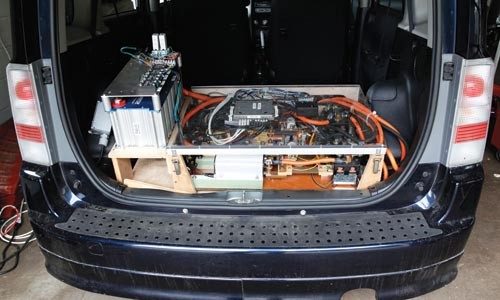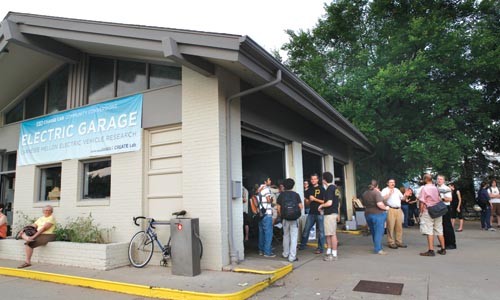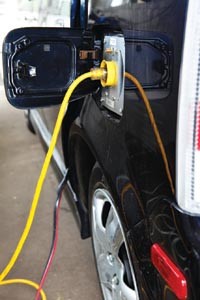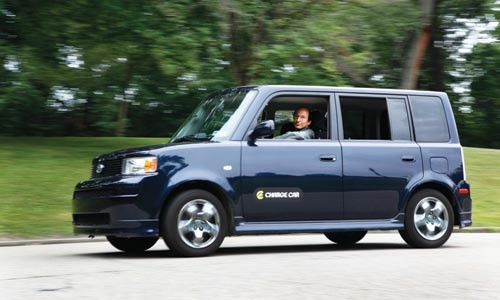
It's just a 2001 Toyota Scion: dark blue, boxy, a little affected. That short nose, that flat, carriage-style roof.
But open the door and sit down inside, and things start looking different. Dials mount the dashboard. A retractable computer screen pops out where the stereo would usually be. Behind you, instead of a back seat and stow area, there's a sprawling array of batteries, wires and electronics. "This is less like a car and more like an airplane," quips the driver, Illah Nourbakhsh.
But most of this is testing gear: You're riding in the prototype for the ChargeCar. The project, led by the Carnegie Mellon University associate professor and colleagues Gregg Podnar and Ben Brown, heralds a new vision for a vehicle whose time, yet again, has come: the electric car.
ChargeCar is based at the Electric Garage -- appropriately enough, a repurposed former Exxon station on Forbes Avenue, near CMU's campus. On a rainy July afternoon, Nourbakhsh backs the car from a service bay. Motoring up rain-slick Forbes in rush-hour traffic, then through campus into Schenley Park, Nourbakhsh demonstrates various ChargeCar features.
It has "regenerative braking," to capture energy conventional cars lose when you hit the brakes. It's dead quiet, except for the hissing of tires on asphalt and the whirring of a brake pump. And though this prototype's top speed is just 45 mph, the fixed-gear ChargeCar accelerates well, easily beating other vehicles off the line as a traffic light turns green.
ChargeCar looks smart on paper, too. The project's goal is affordable conversions of standard, gas-powered cars into plug-in electric vehicles for commuters and other short-mileage users -- people who drive less than 40 miles a day.
If Nourbakhsh and his collaborators can convert a second vehicle, a 2005 Honda Civic, they'll share their methods with local auto garages. The garages could then begin converting Pittsburgh into a capital of plug-in automobility -- at once curbing auto emissions, conserving petroleum, saving drivers money and boosting the local economy.
Riding in the quiet, peppy, tailpipe-free Scion makes that vision seem tantalizingly real. But questions remain. Not least is whether ChargeCar's goal of a conversion "recipe" -- a step-by-step approach to switching a car from gasoline to electricity -- costing as little as $6,000 is feasible.
Moreover, while it's widely agreed that plug-in electric vehicles are a wave of the future, it's uncertain whether there's a place for short-range specialists like the ChargeCar. Will ChargeCar literally go far enough to find a niche among the new generation of EVs from major auto-makers?
Finally, even if it caught on, would ChargeCar really make that much difference? Or is it, after all, just another car?
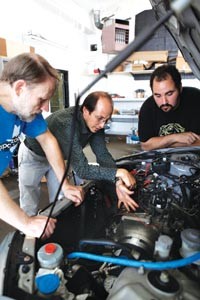
Current Thinking
Electric cars are nothing new. They've been around nearly as long as the gasoline variety that sidelined them a century ago.
The idea resurfaces occasionally, usually touted as a way to help the environment. But in a petroleum-powered society, all-electric cars have struggled for traction.
In the 1990s, plug-ins were hot after a California law mandated phasing in vehicles with zero tailpipe emissions. But just like California's mandate (overturned in a suit brought by automakers), the electric-car revival didn't last: No major automaker has sold one since 2003. (Don't confuse plug-ins with hybrids, which use electric motors to improve mileage on their gas engines.)
There are many reasons why plug-ins like GM's EV1, doomed star of the 2006 cult-favorite documentary Who Killed the Electric Car?, aren't made today -- including, critics say, the malign machinations of Big Oil. But Nourbakhsh says the real problem with electric vehicles is that we've simply been thinking of them wrong.
It all starts with batteries. Gasoline simply contains more energy than we can squeeze into a battery pack of comparable size and weight. And good batteries are expensive. So an electric car that goes as fast and as far, on a single charge, as a gas-powered car on a full tank, will cost you.
Nourbakhsh himself owns an all-electric vehicle. The 2001 Toyota RAV-4, a mini-SUV, is the main family car for he, his wife and two small children, who live in Squirrel Hill. It goes more than 100 miles on a single charge that costs him $2.50 in electricity. In 50,000 miles, the only service it's needed is new brake pads.
But the RAV-4, which carries 1,000 pounds of batteries, cost $35,000 new even after tax credits. It was priced, in other words, for consumers both affluent and adventuresome. (Nourbakhsh paid his off just last year.)
Industry types who characterize electric cars as still not ready for prime time typically cite the need for better batteries. "The size has to come down, they have to work in hot and cold temperatures," Ford Motors chief executive Alan R. Mullaly said at the Washington (D.C.) Auto Show, in January. "We have to get the price down to get widespread use of hybrids or electrics."
But why insist, as GM or Toyota did, that electric cars match their gas-powered brethren in terms of range? Most automobile trips, Nourbakhsh notes, are short: We seldom need the 300-mile capacity conventional cars provide. We just need that commute -- on average, about 8 miles round trip, according to federal statistics. Half of all motorized trips, in fact, are less than 5 miles. In Pittsburgh, informal ChargeCar surveys suggest that 80 percent of commuters drive less than 12 miles round-trip.
Meanwhile, the average American drives about 30 miles a day total -- well within ChargeCar's 40-mile range.
In any case, short trips need only small battery packs, and small battery packs save money -- even if the plug-ins are equipped, like ChargeCar's will be, for highway-ready speeds. Retrofitting modest, popular models like the Civic, rather than buying sleek new plug-ins, also keeps prices down. Add cutting-edge "supercapacitors" and slick software working from detailed knowledge of how people actually drive. Put it all in a recipe -- so conversions can be done by any skilled mechanic, rather than specialists -- and Nourbakhsh believes you have a commuting tool for working people.
ChargeCars wouldn't meet all our transportation needs, of course, or solve all our car-related problems. Like all electric cars, they'd take longer to "refuel" than a gas tank -- a couple hours plugged in to get any range at all, and overnight for a full charge. But even if people kept second cars (which most households have anyway) for long trips, or used rentals, we'd have air a bit cleaner, streets a bit quieter. And we'd have less need of the stuff that's been spewing from a hole in the Gulf of Mexico.
Don't get him wrong: Nourbakhsh is glad auto giants are rolling out plug-ins like the Nissan Leaf, set to debut this fall. But the Leaf claims 100 miles to a charge, and it'll cost about $33,000.
"The lower middle class can't afford it," Nourbakhsh says. "We need something that fills a need, not something that replaces the gas car."
Charging Ahead
Nourbakhsh, 39, came to CMU's Robotics Institute in 1997, from Stanford University. (He's Iranian-born, and his family emigrated to the U.S. in 1977.) As an undergrad, he studied robotics, but the project he calls "mainly my education" was helping build -- and drive -- Stanford's student entry in 1990's 1,600-mile GM Sunrayce road rally for solar-powered cars. The wiry, animated Nourbakhsh still recalls the "rush" he got piloting a fossil-fuel-free, net-zero-energy ride. "That's just magic. That inspires you."
In 2000, he launched CMU's CREATE Lab -- "Community Robots, Education And Technology Empowerment" -- to do projects for the social good. The best-known CREATE project is Gigapan, a system Nourbakhsh and Randy Sargent developed to affordably roboticize ordinary cameras to create large-scale panoramic images. Other initiatives include developing introductory computer-science courses that let high school and college students program interactive robots.
"Almost every project we do is about empowerment," says Nourbakhsh, who also heads CMU's robotics masters program.
ChargeCar began about two years ago, with $300,000 in funding and the motto "Community Electrifying the Urban Commute." Perhaps uniquely in the Robotics Institute, CREATE Lab refuses Department of Defense dollars (a Nourbakhsh ethics mandate), and raises all its own money. The $300,000 in seed money was contributed by nationally known software entrepreneur and philanthropist Donna Auguste and her husband, David Hayes. ChargeCar "has the potential to revolutionize urban commuting," writes Auguste in an e-mail.
ChargeCar, which began converting the Scion last summer, this year found its first commercial collaborator: Baum Boulevard Automotive owner Chuck Wichrowski. Once he helps complete the "recipe," Wichrowski says, "I don't think this is going to be terribly difficult for someone who has to work on a modern vehicle."
In June, ChargeCar began a series of Friday-night open houses at the Electric Garage. The events feature casual conversation with some of the project's two dozen staffers and student workers -- along with corn-on-the-cob and pineapple grilled by Nourbakhsh and film screenings such as (naturally) Who Killed The Electric Car?
The cookouts have typically drawn more than 40 visitors. Some bring their own electric vehicles. Models have ranged from the Zap Xebra -- a Chinese-made, three-wheeled enclosed motorcycle in which Murrysville resident John Belak commutes to work -- to a banana-yellow electric drag-racer hauled north by West Virginia University's Electric Vehicle Association.
Alongside the inveterate enthusiasts were folks like Fred Crum. "I'm tired of paying the gas prices, and what [gasoline] does to the environment," says Crum, a Greenfield resident who owns a tree-cutting service. "I think it would be ideal for me, myself, to own an electric vehicle."
Making ChargeCars affordable, however, won't be easy. Nourbakhsh's goal is a $10,000 conversion; hoped-for federal and state tax credits (now available only for new plug-ins) could drop the cost as low as $6,000.
But "I don't even know that 10,000 [dollars] is achievable," acknowledges Nourbakhsh. "The whole danger with this project is, what if it costs too much?"
Nourbakhsh began driving the Scion, the first test-bed vehicle, in December; he test-drives it daily on the Forbes Avenue-Schenley Park loop. But ChargeCar's future is really riding on the Honda, whose conversion is scheduled for completion by year's end.
The Civic LX was chosen for the first conversion recipe because it's widely available and affordable used. This summer, the gasoline-powered parts were stripped out and -- with help from Baum Boulevard Automotive mechanic Mike Schoenfeld -- replaced by a 48-horsepower electric motor and a "controller," which regulates power to the wheels.
Perhaps surprisingly, converted vehicles aren't lighter; the plug-in Civic will actually be about 150 pounds heavier. Some of that weight's from the 33 lithium-ion batteries, each the size of a phonebook.
Lithium-ion is the new battery of choice for electric cars. Using the technology behind the miniaturization of personal electronic devices, lithium-ions are smaller, more powerful and even less toxic than the familiar lead-acid models. But they share some limitations -- mainly, they can neither charge nor discharge rapidly without degrading.
That's a problem partly because of regenerative braking. In brake-heavy urban environments, capturing the energy normally lost to stopping generates, on average, 25 percent of the power the car needs to run. But gulping that much energy all at once weakens a battery.
Enter the supercapacitor, a device which holds energy not chemically, like a battery, but as static. The one in the Scion could be mistaken for a computer hard-drive. While it can store just a fraction of a battery's energy, a supercapacitor has far more power: It can both accept lots of volts instantly (during braking) and discharge them suddenly, say for uphills. Supercapacitors, says Nourbakhsh, let you use cheaper batteries. They also reduce battery workloads by 25 percent -- potentially doubling lithium-ion battery lifespan, to an estimated seven years -- while themselves outlasting the cars they power.
ChargeCar isn't the first car with supercapacitors. (Honda, for instance, has tested them.) But true to CREATE Lab's empowerment ethos, ChargeCars also rely on input from drivers: Rather than one-size-fits-all conversions, ChargeCars would be custom vehicles, from the size of the battery pack to software that would learn familiar routes and manage energy more efficiently -- say, storing energy in the supercapacitor for a predicted uphill, to avoid overworking the batteries.
If ChargeCar sounds all figured out, however, it's not. For one thing, the team needs to figure out where all the parts go. On July 9, the new lithium-ion batteries were still in their crates as team members tried to decide how to fit them in the Honda. Using foamboard mockups, they discovered that all 33 wouldn't stack under the hood. And because they want the car to seem familiar to drivers, they didn't want to pile them in the trunk or backseat.
Grad student Alex May suggests putting them where the gas tank would be. Removing the transmission is discussed: It's unneeded because, unlike gas engines, electric motors provide good power at all RPMs. Project scientist Ben Brown jokes, "Let's get a bigger car."
Finally, Nourbakhsh decides: Put them in the trunk, but only for now, just to get the car on the road. "We'll learn a ton," he says. "And once we learn that ton, we'll be able to make the right decision."
Range Daze
CMU's Podnar says that by the end of 2011, ChargeCar hopes to have "a few garages" doing conversions. But will Pittsburgh, even if the price is right, go for a car that goes only 40 miles per charge? Even some ChargeCar admirers are skeptical.
"I just don't think it can go as far as people would like it to," says Mike Pokorny, a North Hills machinist who attended the first Electric Garage open house. "It's just gonna take time [to catch on], because people are used to living a certain way."
"It's a marketing challenge," agrees John O'Dell, editor of the online, California-based Green Car Advisor. "People are used to getting into their cars and doing anything they want with [them]."
Car-makers call it "range anxiety": Drivers who know they can go 100 miles fret over a 15-mile commute, because "What if?" Thus, debuting alongside a true plug-in like the Leaf is the much-touted Chevrolet Volt, a "series hybrid" equipped with a "range-extender" -- a small gas engine that does nothing but keep the batteries charged.
Nourbakhsh, the longtime RAV-4 driver, scoffs at such fears: You don't get stranded because "You get really good at knowing distances." Still, Nourbakhsh acknowledges that early on, ChargeCar would appeal most to early adopters, like techies and green true-believers.
Indeed, it seems ChargeCar must create its own niche: somewhere between a family's aging gas car, the costly Leaf and something like the Neighborhood Electric Vehicle, that glorified golf cart driven mostly by residents of planned communities and retirement villages.
"There's a potential market there" for ChargeCars, says O'Dell. "I don't know how big the market is, frankly." And while electricity is cheaper, he adds, gas remains affordable enough to discourage any mass switch to plug-ins. What's more, he notes, "I can still replace a blown engine cheaper than I can do an electric conversion."
Even the popularity of hybrid cars -- a million sold from 2007-09 -- rises and falls with gas prices. Electric-car sales are liable to follow the same trend. "What's lacking at this point in the U.S. is an economic rationale for people to buy them," O'Dell says.
Going Greener?
Environmentally, electric vehicles are often presumed innocent. The cars' silence and lack of visible emissions abets plugs for plug-ins by environmental advocates like Al Gore. If nothing else, electric cars would benefit all cities with smog problems -- which is to say, all cities.
But the reality is more complicated. Sure, in terms of fuel expended per person moved, you can't do much worse than gas-powered automobiles: More than 90 percent of the energy becomes waste heat. Studies show that electric vehicles travel at least five times farther than internal-combustion engines on the same energy. Add the costs of exploring and drilling for oil -- let alone fighting wars over it.
But electricity comes from somewhere, too. The best-case scenario is deriving it from sources that are renewable, or at least lower in greenhouse-gas emissions than coal. That setup makes plug-ins "a massive win" environmentally, says Nourbakhsh. Example: California, which gets most of its electricity from hydropower and natural gas.
Conversely, if plug-ins increased demand for the dirtiest power -- the coal that generates 42 percent of U.S. electricity -- we'd simply shift the burdens of our drill rigs, refineries and tailpipes to strip mines, smokestacks and toxic ash dumps (although such sites, much less numerous than tailpipes, would be easier to regulate). And in Southwestern Pennsylvania, our juice flows mostly from coal.
Yet even that might be a win, if a smaller one: While analyses vary, and while power-plant emissions of soot and such pollutants as sulfur oxide would rise, most studies predict plug-ins would still create less carbon dioxide than burning gasoline.
Going all-electric would, of course, raise electricity bills substantially -- perhaps by 50 percent, if you drove 12,000 miles a year. But experts say that if drivers charged up during off-peak hours (i.e., at night), the current electrical grid could handle it without building much new capacity. And advocates like Nourbakhsh emphasize that plug-ins must go hand-in-hand with a move to renewable energy.
On the other hand, all cars spend most of their energy moving the vehicle, rather than the passenger. And all large-scale electrical generation has environmental costs (even if it's just tiling open fields with solar farms).
An electric car is "still a multi-ton vehicle that requires a lot of money and resources from all over the world to produce," notes Lolly Walsh. Walsh, a staffer for advocacy group BikePittsburgh, speaks as part of the loose-knit international Car Free Network. "If we just develop a different type of car ... it's just going to push back any change that we need to make."
Subsidies to keep America's 246 million cars and trucks running include the billions spent to build and repair endlessly crumbling roads and bridges. Then there's the car-enabled urban sprawl that buries wildlife habitat and farmland while increasing polluted runoff into waterways. Modern America, all spread out, is built around the assumption of near-universal automobile access; it's hard to see such problems lessening as long as Americans are driving an estimated 3 trillion miles a day.
Perhaps the greater feat of engineering would be to stop using 2,500-pound machines to move around 170-pound people. For instance, in their 2009 book After the Car, John Urry and Kingsley Dennis predict that cars as we know them will vanish this century. Urry, a British sociology professor, says that privately owned vehicles (regardless of power source) will simply prove unsustainable. The book explores ideas including car-sharing. As Urry states in an e-mail to CP, "If EVs are deployed more or less like current cars, then they provide little opportunity of effecting a system change."
Nourbakhsh understands the desire to de-emphasize cars. Just five years ago, he says, he biked and bused most trips, and he urged others to do the same.
Then he had kids. His RAV-4 now has two carseats in back. Some days, he says, "The morning is actually a festival of pick-ups and drop-offs in different places."
Though he still bikes to work when he can, Nourbakhsh sees plug-ins as one solution for the future -- his kids' future. "I promised them they'll take their driving test in electric cars."
Upcoming ChargeCar Events at the Electric Garage
Electric Garage Forum (town-hall style meeting), 6 p.m. Fri., July 23.
Community and policy day (with invited speakers), 6 p.m. Fri., July 30.
4621 Forbes Ave., Oakland (across from Carnegie Mellon campus). Free. chargecar.org

